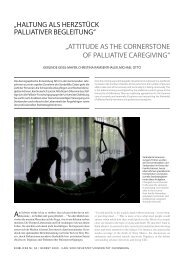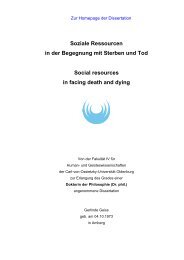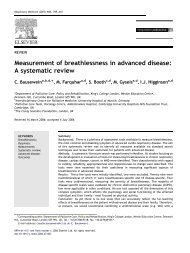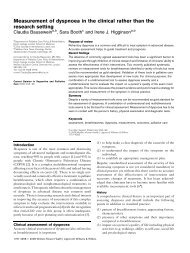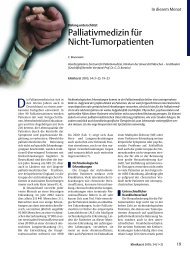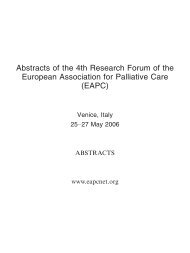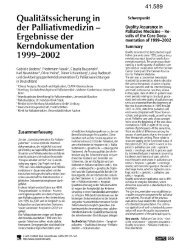EAPC - ipac
EAPC - ipac
EAPC - ipac
You also want an ePaper? Increase the reach of your titles
YUMPU automatically turns print PDFs into web optimized ePapers that Google loves.
414 <strong>EAPC</strong> Abstracts<br />
Objective: To identify and discuss the clinical components of best supportive<br />
care (BSC) packages for patients in lung cancer trials and to determine<br />
to what extent the conduct of clinical and cost-effectiveness analyses<br />
(CEAs) are fully informed. Design: Systematic review of RCTs, systematic<br />
literature reviews (SRs) and economic evaluations (EEs) which compare<br />
chemotherapy versus BSC for adult patients in lung cancer trials. Results:<br />
26 RCTs, 13 SRs and 41 EEs met the review inclusion criteria. Less than<br />
50% of relevant studies included formal definitions of BSC. None of the<br />
papers included in the review adequately described or outlined the BSC<br />
options available to patients, how BSC was delivered or by whom. Data<br />
described in the studies do not facilitate the generation of a clear definition<br />
of a patient pathway in relation to BSC or a clear list of components or costs<br />
of such care. Conclusions: Failure to clearly define BSC packages means<br />
that comparison of treatment outcomes within and across trials is problematic.<br />
Formal definitions of BSC with set parameters for the common complications<br />
of advancing disease, not just the physical symptoms, need to be<br />
established to inform the design of future RCTs and CEAs. From an ethical<br />
perspective, it would seem appropriate to provide patients with an adequate<br />
definition of the care they could expect to receive within the comparator<br />
arm of a cancer trial. Health care professionals involved in the conduct and<br />
reporting of cancer trials must aim to communicate the BSC package delivered<br />
to patients.<br />
49 Invited Lecture<br />
Best Supportive Care versus chemotherapy The right question<br />
to ask<br />
Optimal outcomes for studies comparing best supportive care<br />
with chemotherapy<br />
Authors: Fausto Roila Medical Oncology Division ITALY<br />
Sonia Fatigoni Medical Oncology Division Perugia ITALY<br />
Until 10 – 15 years ago chemotherapeutic agents have been introduced in<br />
the clinical practice on the base of their activity represented by the rates of<br />
complete and, more frequently, partial responses, their duration and the<br />
time to the disease progression. On the other hand, these variables did not<br />
necessarily have a clear relationship to the treatment’s impact on survival<br />
and quality of life, that represent the indexes of efficacy. Therefore, many<br />
subsequent phase III studies in several disseminated cancer patients compared<br />
the chemotherapeutic agents with respect to the best supportive care<br />
to demonstrate their efficacy. Even not clearly defined and standardized,<br />
best supportive therapy means the best control of the cancer symptoms in<br />
the clinical practice. Today, we have several of these studies carried out for<br />
example in lung, gastric, pancreatic disseminated cancer that often showed<br />
the superiority of the chemotherapeutic agents or combinations in terms of<br />
overall median survival without a negative impact on the quality of life. Of<br />
course, these studies should have been planned with a sound methodology<br />
(i.e., randomized, prospective, if possible blind studies with a sample size<br />
calculation, using validated quality of life instruments, etc.).<br />
Unfortunately, until recently, this has not been the case for many of these<br />
studies as we will discuss in the presentation. Furthermore, it is necessary<br />
to outline that these studies in any case need to be well interpreted. For<br />
example, the frequent impossibility to blind the treatments even if have not<br />
impact on survival conditioned their effect on quality of life (symptoms<br />
and adverse effects, psychological status, social relationship, etc). This is<br />
also true for double blind, placebo-controlled, phase III studies evaluating<br />
the efficacy and tolerability of target therapies in which adverse events<br />
(i.e., skin toxicity) permit to recognize patients submitted to the treatment<br />
with respect to those submitted to placebo. Finally, the administration of<br />
large doses of corticosteroids for more consecutive days to avoid adverse<br />
events of chemotherapeutic agents, as in the case of docetaxel, could<br />
induce a better quality of life with respect to patients receiving best<br />
supportive care alone due to impact of corticosteroids on symptoms (amelioration<br />
of anorexia, asthenia, nausea and cenestesis). In this case we<br />
erroneously could have attributed this result on quality of life to the<br />
chemotherapeutic agents.<br />
50 Invited Lecture<br />
Best Supportive Care versus chemotherapy The right question<br />
to ask<br />
BSC a faulted methodology in need of standards<br />
Authors: Nathan Cherny Shaare Zedek Medical Center Director Cancer<br />
Pain and Palliative Medicine, Dept Oncology ISRAEL<br />
(BSC) in two 1988 articles reporting on chemotherapy studies initiated in<br />
1983–84. The qualifier “best” implies that patients are provided optimal<br />
palliative care. Most studies which employ a best supportive care arm<br />
enroll patients with poorly responsive cancers such as non-small cell lung<br />
cancer and colorectal cancer. Usually, but not invariably, the supportive<br />
care arm is found to be inferior to the chemotherapy arm with respect to<br />
objective tumor response and survival. It was subsequently concluded that<br />
it is almost always better to receive treatment than to be referred for palliative<br />
care. This literature is intrinsically misleading since the term “BSC”<br />
does not represent any formally defined concept, rather, it evolved as a<br />
politically correct alternative to “no chemotherapy” that would be palatable<br />
to both patients and ethical review boards. In actuality the “BSC” provided<br />
in these studies can, at best be described as ad-hoc provision of supportive/palliative<br />
care by oncology physicians with no specific training.<br />
Indeed, one may suspect that in some studies the so-called “best supportive<br />
care” may more accurately be expressed as “not-so-best supportive<br />
care”. This suggestion is supported by a very well developed literature<br />
indicating that many oncologists have deficient skills in the management<br />
of pain and palliative care. This adds further to the doubt that in the<br />
absence of highly specified programs involving palliative care physicians,<br />
patients would have received “BSC”. The methodologies in these studies<br />
are characterized by a paucity of data describing “BSC”. Overall the treatment<br />
programs were reactive i.e. that people can receive antibiotics for<br />
infection, opioids for pain, blood transfusions for anemia, etc. Not one<br />
investigator involved a palliative care or hospice team in a study. It is thus<br />
impossible to draw conclusions at to the relative merit of skilled palliative<br />
care as compared to chemotherapy for this patient group. This analysis<br />
underscores the need for clear standards for the “BSC” arm of clinical studies<br />
seeking to address this important question.<br />
51 Invited Lecture<br />
The Trial of Trials in Palliative Care Research<br />
Choosing a placebo<br />
Authors: Claudia Bausewein Dept. of Palliative Care, Policy &<br />
Rehabilitation Kings’s College London UNITED KINGDOM<br />
Randomised controlled trials (RCTs) aim to establish the efficacy of a new<br />
intervention. If there is no active or standard beneficial treatment placebos<br />
are often used as controls. A placebo is defined as a substance without a<br />
pharmacological effect or a sham treatment or an inactive procedure. The<br />
so-called placebo effect is a non-specific effect related to the credibility of<br />
the intervention, patients’ expectations and the therapeutic setting. There is<br />
controversy about the size of the placebo effect. It has been questioned<br />
whether there is an effect at all. Mostly it has been estimated to be about<br />
30% but beneficial results of up to 60–90% have been reported. However,<br />
the claimed effects may be due to spontaneous improvement, fluctuation of<br />
symptoms, regression to the mean, additional treatment, answers of politeness,<br />
scaling bias etc. Careful attention has to be given to which placebo to<br />
choose. This might be straight forward in a drug trial. Originally, RCTs<br />
focused on drugs with a bio-medical theory base. A drug is prescribed on<br />
the base of a bio-medical diagnosis which has been established beforehand.<br />
In these pharmacological trials inert dummy pills are frequently used as<br />
placebos. However, more recently complex interventions such as acupuncture<br />
or psychotherapy or multi-professional palliative care interventions<br />
are also tested in RCTs. Often complex interventions such as acupuncture<br />
have a non-biomedical theory base where talking and listening to patients<br />
are part of the intervention. In trials with experience-based treatments it is



